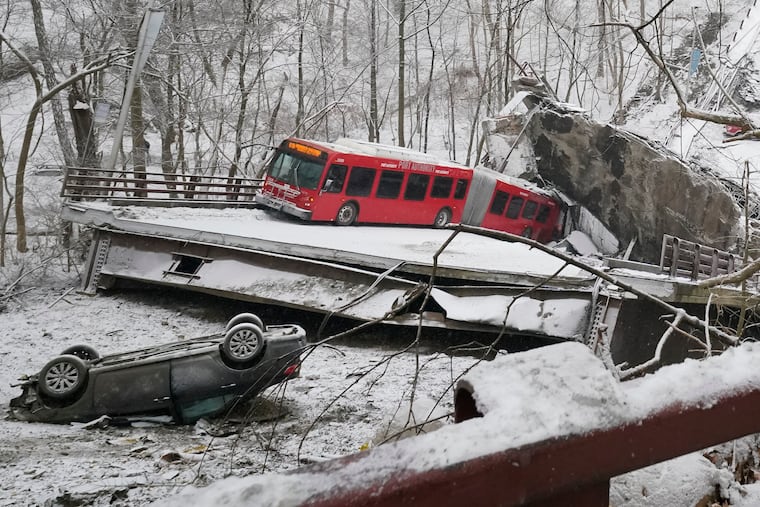A Pittsburgh bridge collapsed right before President Biden arrived in town to talk infrastructure
The bridge was in “poor” condition, a government designation used to describe a span as needing overhaul but not in imminent danger of failure.

A bridge over a creek in Pittsburgh collapsed Friday morning hours before President Joe Biden was to arrive in the city to talk about the $1 trillion bipartisan infrastructure law and the sorry state of public works, including roads and bridges, in the U.S.
After a quick visit to the shattered bridge, Biden spoke as scheduled, referencing the tragedy as impetus for the package of spending to improve the country’s bridges, roads, sewers, pipes, and ports.
“The next time, we don’t need headlines saying that someone was killed,” Biden said, just after visiting the site Friday afternoon. “We saw today [that] when a bridge is in disrepair, it literally can threaten lives.”
What happened in Pittsburgh?
Here are the basics:
No fatalities were reported, but 10 people sustained injuries that were described by authorities as non-life-threatening. Several went to hospitals.
Biden visited the collapse site shortly before 1:30 p.m., and, placing his hand on the shoulder of a police officer, said first responders “deserve an incredible amount of credit.”
The president told pool reporters at the scene that the bridge would be fixed as part of the new federal infrastructure act. Noting that Pittsburgh purportedly has more bridges than any other city in the world and that many other bridges in the U.S. are in poor shape, Biden said: “We’re going to fix them all.”
In his speech later, the president acknowledged there will be “much more work to be done” even after the infrastructure funds are spent.
The National Transportation Safety Board said, in a tweet, that it would investigate the collapse and was sending an initial “go-team” of experts to the site.
The bridge that collapsed Friday was listed as being in “poor” condition, a designation used by states and the federal government to describe a span as needing overhaul but not in imminent danger of failure; those bridges are typically closed to traffic.
Bystanders form a human chain
Emergency rescuers had to rappel 150 feet down to the Fern Hollow Creek, the Associated Press reported. Bystanders formed a human chain to help passengers off a transit bus that was left dangling after the collapse.
Where in Pittsburgh did this happen?
The collapse was in Frick Park, a 644-acre oasis on the city’s east side between the neighborhoods of Squirrel Hill and Regent Square. The bridge, which was snow-covered, went down shortly before 7 a.m. It carried Forbes Avenue over the creek.
$1.6 billion for Pennsylvania to fix bridges
Transportation Secretary Pete Buttigieg visited Philadelphia two weeks ago to announce $27.5 billion in new federal aid to states to rehabilitate aging bridges, including $1.6 billion for Pennsylvania, over five years. The money comes from the federal infrastructure act.
State transportation departments will pass on the federal aid to specific bridge projects identified as the most crucial, in concert with regional planning commissions. U.S. DOT has issued guidance encouraging states to repair existing structures — though they are free to build new bridges if they choose.
» READ MORE: Pa. will get $1.6 billion to fix bridges, like the MLK Bridge across the Schuylkill
But, for the first time, there is an incentive for states to focus spending on smaller bridges owned by counties, cities, and towns — like the one that fell down in Pittsburgh on Friday. The federal government will cover 100% of the cost of work on those spans, but states and local government will need to pay the normal 20% local share of the cost of repairs to bridges on interstates and designated federal highways.
What do we know about the bridge that collapsed?
The Fern Hollow Bridge, a steel rigid frame bridge about 10 miles east of downtown, was built in 1970, according to PennDot data. Its understructure was rated as “satisfactory,” though overall it was labeled “poor” and had posted weight limits, according to the state. It carried an estimated 14,500 vehicles a day. The bridge is the city’s responsibility.
Could any Philadelphia bridges have similar issues?
Philadelphia has a number of bridges in similar or worse condition.
While Pittsburgh is famously known as the “City of Bridges” for its many spans, PennDot tracks nearly 600 bridges in Philadelphia, including highways, overpasses, viaducts, and other similar elevated structures — 82 of these are listed as being in “poor” condition and 17 in “serious” or “critical” condition. Some, like a stretch of Martin Luther King Drive over the Schuylkill, have been preemptively closed to traffic due to deferred maintenance.
Both the city and PennDot, which is responsible for maintaining certain roadways in Philadelphia, are likely to focus the new federal dollars — a historic allocation but limited in relation to the need — on more high-profile structures.
A PennDot spokesperson said the agency was prioritizing nearly $150 million in repairs to Market Street’s iconic crossing over the Schuylkill.
But analysis of the repair backlog shows numerous lesser-known bridges, including sections of I-95 that are under construction as part of a massive rebuild, have been improved but are still listed in poor condition. Many of them carry city streets over the railroad lines that crisscross Philadelphia.
Bridges carrying portions of Broad Street over railroad tracks were marked in poor condition, as were others along busy sections of Second and 15th Streets.
The city also has already closed a section of Margie Street spanning railroad tracks in North Philadelphia that was listed as “imminently dangerous.”
Some bridges in city parks also have issues. Spans along Valley Green Road and Bell’s Mills Road, both in the Wissahickon Valley Park, were recorded as being in worse shape than the portion of the Pittsburgh bridge that collapsed. The second of the two was listed in “critical” condition.
This story contains reporting from the Associated Press and Washington Post.